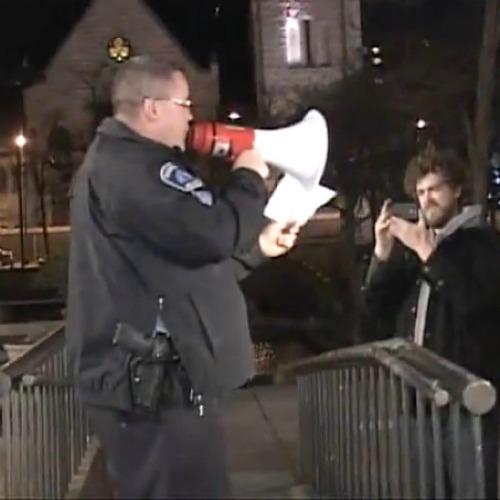BOB GARFIELD: This is On the Media. I’m Bob Garfield. In April, after the arrest of a dozen protestors for obstructing the flow of traffic in an Occupy Minnesota demonstration in Minneapolis, the occupiers posted videos on YouTube, which showed several of them apparently being roughed up by the police. To view the tape, you’d gather that the police simply moved in and commenced arresting protestors without warning.
But there was another camera rolling that night, one belonging to the police themselves. And in response to the protestors’ video, the Minnesota Police Department posted around 20 minutes of raw footage on its new YouTube channel. On that video, you can clearly see the police delivering several warnings by bullhorn.
[YOUTUBE CLIP]:
MPD OFFICER: If you fail to remove your properties on the Plaza, the Minneapolis Police Department will take enforcement action. I want to thank you in advance for your cooperation.
[END CLIP]
BOB GARFIELD: Incoming Minneapolis Police Chief Janee Harteau says that MPD’s new YouTube channel was originally meant as a repository of raw footage to shine a light on police work, but after the Occupy incident they realized they could use the channel to level the playing field.
CHIEF JANEE HARTEAU: It never occurred to us at the time to be proactive. We tend to be reactive to somebody that comes forward and either makes accusations or you see small news clips on television, because they have a short period of time. And here we had a 20-minute or so video that could show the entire story.
BOB GARFIELD: Well, not the entire story. Multiple video points of view are better than fewer and raw footage is better than edited footage, but your cameraperson’s fairly close-up perspective did obscure some of the things that did come out on some Occupy video, for example, an officer knocking down one of the protestors and the camera going to the street. And I think some of that just had to do with the close-up vantage. Who was shooting this for you?
CHIEF JANEE HARTEAU: Our Crime Lab videographers were out at the scene.
BOB GARFIELD: And there’s the problem. They have a kind of close-up mentality.
CHIEF JANEE HARTEAU: Correct.
BOB GARFIELD: Did you ask them subsequently to do a little more pull-back to reveal?
CHIEF JANEE HARTEAU: The pull-back but also to try to have multidimensional. Cameras will tell the story of what they see, and so the more dimensions we have and the more cameras we have, obviously, we can get a better picture of all the scenarios as to what’s happened.
BOB GARFIELD: This all makes very good sense, to add perspective to what is almost, by definition, a chaotic situation. But I’m wondering how long your efforts at radical transparency will last. For example, what happens if your police cameras capture your officers violating departmental policy, or possibly even the law, making your video evidentiary and perhaps prohibiting you from posting it routinely online?
CHIEF JANEE HARTEAU: When things are evidence, yes, we will have to withhold that, but we will certainly deal with any video that shows misconduct of any kind, just as we would if a citizen brought that video in. The incident you discussed about the camera-man was brought before Internal Affairs and is being dealt with.
BOB GARFIELD: Tell me about your own ranks. Are there officers grumbling about having Big Brother looking over their shoulder while they’re trying to go about their business?
CHIEF JANEE HARTEAU: Officers have always been a little bit hesitant with video. But that documentation has saved officers, more often than not, from frivolous accusations. I’m very proud of the officers here and their work. And we need to be able to show what they do.
And officers should assume, frankly, that they’re always being videotaped. There are six cameras throughout the city. There’s squad cameras that people may not know that are running. I mean, the technology is there, and so the assumption should be made that they’re under surveillance.
BOB GARFIELD: As you look at video of the Occupy protests, everybody’s got a cell phone, and they’re all taking pictures of the police work in progress. How has this changed police work in Minneapolis?
CHIEF JANEE HARTEAU: When you see that people are using cameras, there are times that it actually interferes with an officer’s ability to do their job. I realize that people want to see what occurred, and they want to document that, but police also have a job to do. And their goal is to facilitate and support freedom of speech, protect people’s rights and keep them safe. So it does become more challenging.
It also becomes challenging when it comes to going to court because the concern is an officer’s word doesn’t mean as much as it used to, if it doesn’t have corroborating video or DNA. And that’s unfortunate, because there are gonna be times that the camera didn’t work or the camera didn’t capture that view, or the camera’s facing forward but what occurred is behind you. So it’s a tool, but it’s not a guarantee. It’s not a fix, it’s not an end-all.
BOB GARFIELD: All right. Chief, thank you very much.
CHIEF JANEE HARTEAU: Thank you.
BOB GARFIELD: Chief Janee Harteau is the incoming chief of police for the City of Minneapolis.

